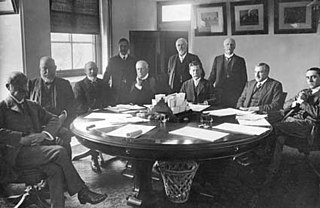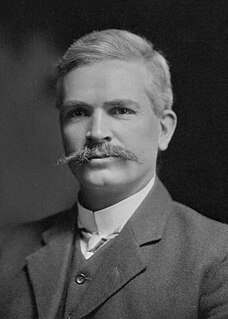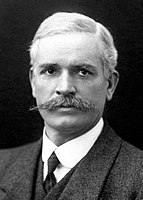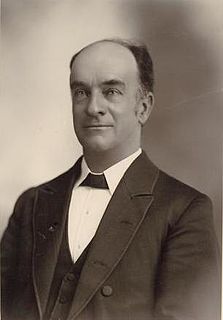
Sir Joseph Cook, was an Australian politician who served as the sixth Prime Minister of Australia, in office from 1913 to 1914. He was the leader of the Commonwealth Liberal Party from 1913 to 1917, after earlier serving as the leader of the Anti-Socialist Party from 1908 to 1909.
The Protectionist Party was an Australian political party, formally organised from 1887 until 1909, with policies centred on protectionism. It advocated protective tariffs, arguing it would allow Australian industry to grow and provide employment. It had its greatest strength in Victoria and in the rural areas of New South Wales. Its most prominent leaders were Sir Edmund Barton and Alfred Deakin, who were the first and second prime ministers of Australia.

The 1998 Australian federal election was held to determine the members of the 39th Parliament of Australia. It was held on 3 October 1998. All 148 seats of the House of Representatives and 40 seats of the 76-seat Senate were up for election. The incumbent centre-right Liberal/National Coalition government led by Prime Minister John Howard of the Liberal Party and coalition partner Tim Fischer of the National Party defeated the centre-left Australian Labor Party opposition led by Opposition Leader Kim Beazley.
The Commonwealth Liberal Party was a political movement active in Australia from 1909 to 1917, shortly after Federation. The CLP came about as a result of a merger between the two non-Labor parties, the Protectionist Party and the Anti-Socialist Party which most of their MPs accepted. The CLP is the earliest direct ancestor of the current Liberal Party of Australia.

The Cook Ministry was the 10th ministry of the Government of Australia. It was led by the country's 6th Prime Minister, Joseph Cook. The Cook Ministry succeeded the Second Fisher Ministry, which dissolved on 24 June 1913 following the federal election that took place in May which saw the Commonwealth Liberals defeat Andrew Fisher's Labor Party - albeit with a one-seat majority. The ministry was replaced by the Third Fisher Ministry on 17 September 1914 following the federal election that took place on 5 September which saw Labor defeat the Commonwealth Liberals.

Federal elections for the inaugural Parliament of Australia were held in Australia on Friday 29 March and Saturday 30 March 1901. The elections followed Federation and the establishment of the Commonwealth of Australia on 1 January 1901. All 75 seats in the Australian House of Representatives, six of which were uncontested, as well as all 36 seats in the Australian Senate, were up for election.

The politics of Australia take place within the framework of a federal parliamentary constitutional monarchy. Australians elect parliamentarians to the federal Parliament of Australia, a bicameral body which incorporates elements of the fused executive inherited from the Westminster system, and a strong federalist senate, adopted from the United States Congress. Australia largely operates as a two-party system in which voting is compulsory. The Economist Intelligence Unit has rated Australia as a "full democracy" in 2017.

Charles McDonald was an Australian politician who served in the House of Representatives from 1901 until his death, representing the Labor Party. He was Speaker of the House of Representatives from 1910 to 1913 and from 1914 to 1917. Before entering federal politics, McDonald had served in the Queensland Legislative Assembly from 1893 to 1901.
Federal elections were held in Australia on 12 December 1906. All 75 seats in the House of Representatives, and 18 of the 36 seats in the Senate were up for election. The incumbent Protectionist Party minority government led by Prime Minister Alfred Deakin retained government, despite winning the fewest House of Representatives votes and seats of the three parties. Parliamentary support was provided by the Labour Party led by Chris Watson, while the Anti-Socialist Party, led by George Reid, remained in opposition.

Federal elections were held in Australia on 29 May 1954. All 121 seats in the House of Representatives were up for election, but no Senate election took place. The incumbent Liberal–Country coalition led by Prime Minister Robert Menzies defeated the opposition Labor Party led by H. V. Evatt, despite losing the two-party preferred vote.

Federal elections were held in Australia on 28 April 1951. All 121 seats in the House of Representatives and all 60 seats in the Senate were up for election, due to a double dissolution called after the Senate rejected the Commonwealth Bank Bill. The incumbent Liberal–Country coalition led by Prime Minister Robert Menzies defeated the opposition Labor Party with a modestly reduced majority, and secured a majority in the Senate. Chifley died just over a month after the election.

Federal elections were held in Australia on 10 December 1949. All 121 seats in the House of Representatives and 42 of the 60 seats in the Senate were up for election. The incumbent Labor Party, led by Prime Minister Ben Chifley, was defeated by the opposition Liberal–Country coalition under Robert Menzies. Menzies became prime minister for a second time, his first term having ended in 1941.

Federal elections were held in Australia on 17 November 1928. All 75 seats in the House of Representatives and 19 of the 36 seats in the Senate were up for election. The incumbent Nationalist–Country coalition, led by Prime Minister Stanley Bruce, defeated the opposition Labor Party led by James Scullin.

Federal elections were held in Australia on 5 May 1917. All 75 seats in the House of Representatives and 18 of the 36 seats in the Senate were up for election. The incumbent Nationalist Party, led by Prime Minister Billy Hughes, defeated the opposition Labor Party led by Frank Tudor.

Federal elections were held in Australia on 31 May 1913. All 75 seats in the House of Representatives, and 18 of the 36 seats in the Senate were up for election. The incumbent Labor Party, led by Prime Minister Andrew Fisher, was defeated by the opposition Commonwealth Liberal Party under Joseph Cook. The new government had a majority of just a single seat, and held a minority of seats in the Senate. It would last only 15 months, suffering defeat at the 1914 election.

Federal elections were held in Australia on 13 April 1910. All 75 seats in the House of Representatives, and 18 of the 36 seats in the Senate were up for election. The incumbent Commonwealth Liberal Party led by Prime Minister Alfred Deakin was defeated by the opposition Labour Party, led by Andrew Fisher.
This article provides information on candidates who stood for the 1917 Australian federal election. The election was held on 5 May 1917.
The history of the Australian Labor Party has its origins in the Labour parties founded in the 1890s in the Australian colonies prior to federation. Labor tradition ascribes the founding of Queensland Labour to a meeting of striking pastoral workers under a ghost gum tree in Barcaldine, Queensland in 1891. The Balmain, New South Wales branch of the party claims to be the oldest in Australia. Labour as a parliamentary party dates from 1891 in New South Wales and South Australia, 1893 in Queensland, and later in the other colonies.

















